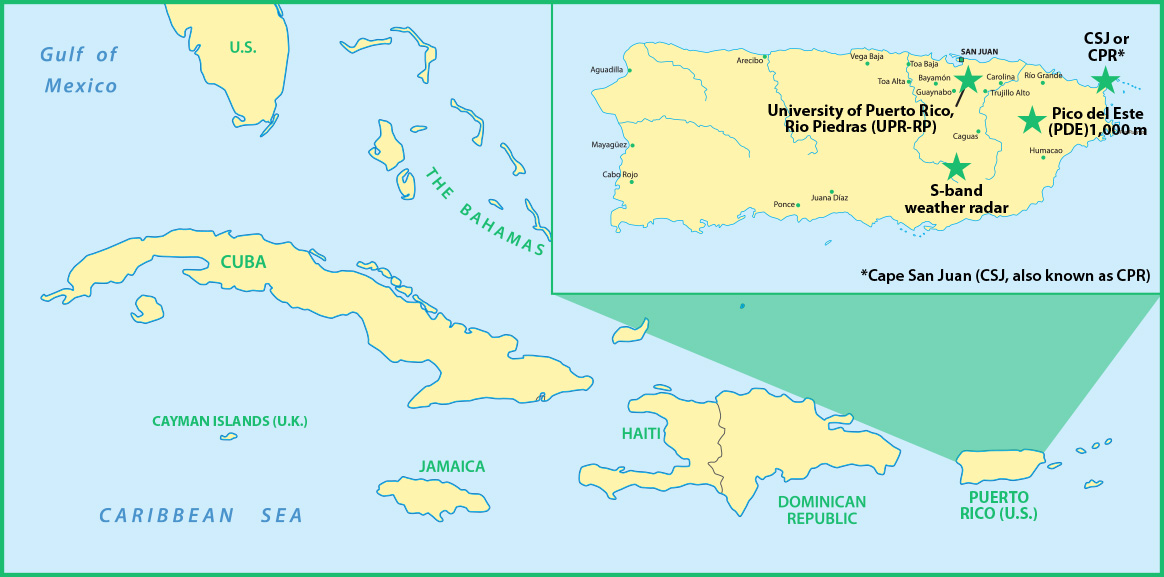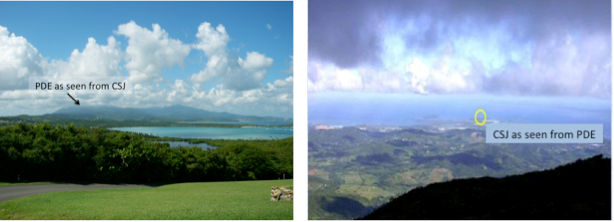LAMP
Long-Term Aerosol Measurements in Puerto Rico
4 June 2018 - 1 February 2024
Lead Scientist: Olga Mayol Bracero
Observatory: OSC
 Since 2004, the University of Puerto Rico, Rio Piedras, (UPR-RP) has been making continuous measurements of aerosol optical, chemical, and microphysical properties at Cape San Juan (CSJ, also known as CPR). This site also hosted a number of intensive field campaigns, with context provided by the long-term measurements. Hurricane Maria largely destroyed the station on September 20, 2017, forcing a cessation of the measurements. The scientific focus of this field campaign is to use an ARM Mobile Facility (AMF) aerosol shelter to enable resumption of the long-term aerosol measurements, which are used to:
Since 2004, the University of Puerto Rico, Rio Piedras, (UPR-RP) has been making continuous measurements of aerosol optical, chemical, and microphysical properties at Cape San Juan (CSJ, also known as CPR). This site also hosted a number of intensive field campaigns, with context provided by the long-term measurements. Hurricane Maria largely destroyed the station on September 20, 2017, forcing a cessation of the measurements. The scientific focus of this field campaign is to use an ARM Mobile Facility (AMF) aerosol shelter to enable resumption of the long-term aerosol measurements, which are used to:
- characterize long-term trends and variability of aerosol climate-forcing properties
- link those properties to aerosol sources and long-range transport
- study the influence of aerosols at CSJ on cloud chemical and microphysical properties at the companion site on Pico del Este (PDE) cloud forest, above and downwind of CSJ.
 The proposed deployment of the AMF aerosol shelter complements the ARM mission “To provide the climate research community with strategically located in situ and remote-sensing observatories designed to improve the understanding and representation, in climate and Earth system models, of clouds and aerosols as well as their interactions and coupling with the Earth’s surface.” The companion sites CSJ and PDE are strategically located in the Caribbean region to provide long-term measurements of aerosols, and in particular aged Saharan dust, in the marine boundary layer and their interactions with the clouds above and downwind. While the complement of instruments at these sites is much less comprehensive than at the ARM observatories or AMF deployments, the long-term nature of the CSJ and PDE measurements will provide the context for possible future AMF deployments in a different climate regime from those emphasized by ARM. Furthermore, public access to the CSJ and PDE measurements through the ARM Data Center and the WMO World Data Center for Aerosols will facilitate discovery and use of these data by DOE's Atmospheric System Research program and other investigators. The experimental methods are nearly identical to those used in the first AMF aerosol observing system, which provide measurements with 1-minute time resolution of aerosol number concentration, total and backwards-hemispheric light scattering coefficients and light absorption coefficients at three wavelengths and two size ranges, multi wavelength aerosol optical depth and derived column-averaged aerosol properties (NASA’s AERONET retrievals), and cloud condensation nuclei concentrations. In addition, collected filter samples are analyzed for carbonaceous aerosols (thermal/optical analysis), water-soluble ions (ion chromatography), trace metals (inductively coupled plasma), elemental composition (X-ray fluorescence), and mass concentrations (gravimetric analysis). An example of how these data have been used, and will continue to be used in the future, is the climatology reported by Rivera et al. [manuscript in preparation].
The proposed deployment of the AMF aerosol shelter complements the ARM mission “To provide the climate research community with strategically located in situ and remote-sensing observatories designed to improve the understanding and representation, in climate and Earth system models, of clouds and aerosols as well as their interactions and coupling with the Earth’s surface.” The companion sites CSJ and PDE are strategically located in the Caribbean region to provide long-term measurements of aerosols, and in particular aged Saharan dust, in the marine boundary layer and their interactions with the clouds above and downwind. While the complement of instruments at these sites is much less comprehensive than at the ARM observatories or AMF deployments, the long-term nature of the CSJ and PDE measurements will provide the context for possible future AMF deployments in a different climate regime from those emphasized by ARM. Furthermore, public access to the CSJ and PDE measurements through the ARM Data Center and the WMO World Data Center for Aerosols will facilitate discovery and use of these data by DOE's Atmospheric System Research program and other investigators. The experimental methods are nearly identical to those used in the first AMF aerosol observing system, which provide measurements with 1-minute time resolution of aerosol number concentration, total and backwards-hemispheric light scattering coefficients and light absorption coefficients at three wavelengths and two size ranges, multi wavelength aerosol optical depth and derived column-averaged aerosol properties (NASA’s AERONET retrievals), and cloud condensation nuclei concentrations. In addition, collected filter samples are analyzed for carbonaceous aerosols (thermal/optical analysis), water-soluble ions (ion chromatography), trace metals (inductively coupled plasma), elemental composition (X-ray fluorescence), and mass concentrations (gravimetric analysis). An example of how these data have been used, and will continue to be used in the future, is the climatology reported by Rivera et al. [manuscript in preparation].
Other examples are: Schmeisser et al. (2017), Denjean et al. (2016), Denjean et al. (2015), Gioda et al. (2011), and Allan et al. (2008).
Instruments at the site include:
- TSI integrating nephelometer
- NOAA continuous light absorption photometer
- Magee Scientific aethalometer
- TSI condensation particle counter
- CCN counter
- Weather station
- CIMEL sun/sky radiometer, part of NASA’s Aeronet
- GRIMM optical particle counter
- TSI scanning mobility particle sizer
- Tapered Element Oscillating Microbalance
- Filter and impactor aerosol samplers.
Collaborators are: P Sheridan and E Andrews, NOAA ESRL/GMD – support with data acquisition and processing JA Ogren, NOAA retired – aerosol measurements D Baumgardner, DMT – cloud measurements JM Prospero, RSMAS, University of Miami – aerosols and dust C Gaston, RSMAS, University of Miami – aerosols and dust D Farrel and A Sealy, CIMH, Barbados – WMO SDS WAS
CPR belongs to the following Atmospheric Networks NASA Aeronet since 2004 NOAA ESRL Expanded Long-term Aerosol Network since 2004 WMO GAW Regional station since 2015, contributing since 2004
Related Publications
View all- Mayol-Bracero et al. Aerosol Optical Properties as Part of the Long-Term Aerosol Measurements in Puerto Rico (AOP-LAMP) Field Campaign Report. 2024. 10.2172/2482302.
Timeline
Campaign Data Sets
| IOP Participant | Data Source Name | Final Data |
|---|---|---|
| Olga Mayol-Bracero | Cloud Condensation Nuclei Counter | Order Data |
Keep up with the Atmospheric Observer
Updates on ARM news, events, and opportunities delivered to your inbox
ARM User Profile
ARM welcomes users from all institutions and nations. A free ARM user account is needed to access ARM data.


















